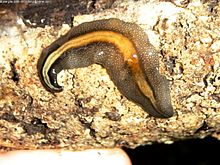Terricola
| Geoplanidae | |
|---|---|
 |
|
| Obama burmeisteri from the Atlantic rainforests of southern Brazil | |
| Scientific classification | |
| Kingdom: | Animalia |
| Phylum: | Platyhelminthes |
| Class: | Rhabditophora |
| Order: | Tricladida |
| Suborder: | Continenticola |
| Family: |
Geoplanidae Stimpson, 1857 |
| Subfamilies | |
| Synonyms | |
|
Terricola Hallez, 1857 |
|
Terricola Hallez, 1857
Geoplanidae is a family of flatworms known commonly as land planarians or land flatworms.
These flatworms are mainly predators of other invertebrates, which they hunt, attack and capture using physical force and the adhesive and digestive properties of their mucus. They lack water-retaining mechanisms and are therefore very sensitive to humidity variations of their environment.
Because of their strict ecological requirements, some species have been proposed as indicators of the conservation state of their habitats. They are generally animals with low vagility (dispersal ability) and with very specific habitat requirements, so they can be also used to accurately determine the distribution of ecozones. Today the fauna of these animals is being studied to select conservation priorities in the Atlantic rainforest in Brazil.
At the other extreme, one species in this family, Platydemus manokwari has become an invasive species in both disturbed and wild habitats in the Pacific Islands, and has damaged the endemic land snail faunas. This species has been found in Europe (France) in 2013 for the first time, and in 2015 in New Caledonia, Wallis and Futuna Islands, Singapore, Solomon Islands, Puerto Rico (first record in the Caribbean), and Florida, USA.
Land planarians are distinguished from their marine and freshwater relatives by their terrestrial habits, as well as by morphological distinctions. Some species have dull colors, including shades of brown and grey, that make them inconspicuous in their environment, but most species are marked by very colorful patterns. At first they may be confused with slugs or leeches, but they lack the anterior tentacles of slugs and the segmentation of leeches. Their size vary greatly, from a few millimeters in length to about one meter.
...
Wikipedia
